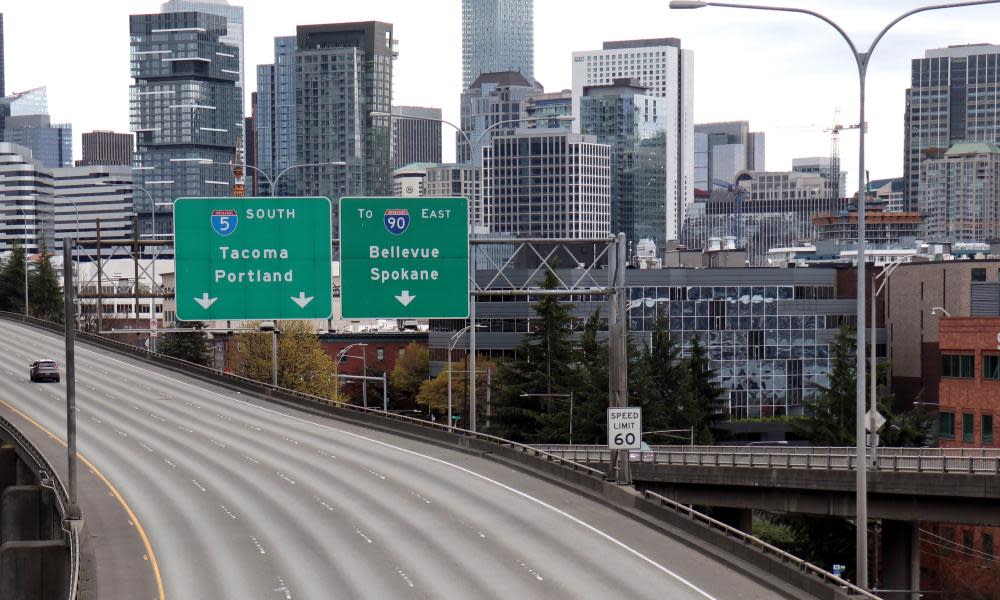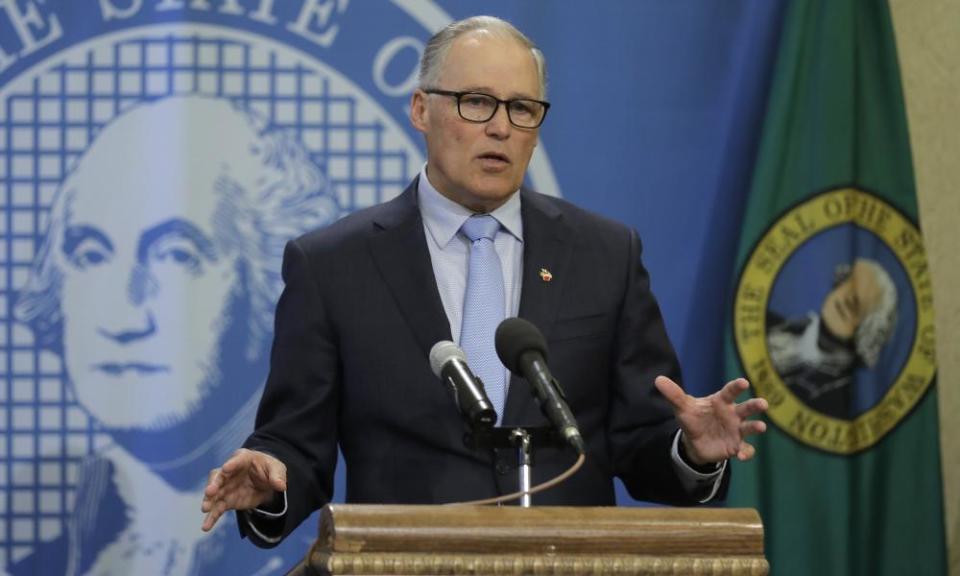Washington state begins to ask: how does the coronavirus crisis end?

The first person confirmed to have tested positive for the coronavirus in the US by the federal Centers for Disease Control and Prevention (CDC) was a resident of Snohomish county, Washington.
Related: Coronavirus threatens survival of US rural hospitals on frontlines of crisis
That was on 21 January. In the weeks that have followed, the state, which has a population of more than 7.5 million people, has seen over 9,000 confirmed cases, including 421 deaths.
Washington’s governor, Jay Inslee, has closed schools, ordered a halt to all elective surgeries and issued a stay-home mandate, which involves a ban on all gatherings and the closure of all businesses, except grocery stores, pharmacies, gas stations and other essential companies. Last week, he extended that order to 4 May, saying that was “absolutely the soonest we possibly could achieve our ends to keep our loved ones safe.”
But though the path back to “normal” life is still some way off, the state’s early and comprehensive response looks to be flattening the curve of coronavirus infections. With the worsening of the financial crisis brought on by the public health emergency, that has prompted the questions: when, and how, could this end?
Dr Anthony Fauci, America’s leading expert on infectious diseases, recently explained that it will be clear the outbreak is nearing its conclusion in the US when the number of new infections is approaching almost zero and the number of deaths is not far behind.
“I believe that in a few months, hopefully, that we’ll get it under control enough that it won’t be as frightening as it is now, but it will not be an absent threat,” he told the New York Times.
Washington saw the initial outbreak of the virus in the US and, after the infection struck a nursing home in the state, reported the country’s highest numbers of cases and deaths for weeks. But the state has since moved far behind hotspot states like New York and California, which have far greater populations of almost 20 million and 40 million respectively. Today, Washington state has the 11th-highest number of cases in the US, according to the CDC.
A projection from the Institute for Health Metrics and Evaluation, an independent population health research center at UW Medicine, shows that Washington hit its peak in coronavirus deaths 11 days ago, with 24 fatalities. In contrast, New York’s peak is projected to hit this week, while California’s is not expected to take place until 17 April.
Washington’s low numbers can be attributed to the simple fact that its cities are less dense than those in states like New York and California. Its communities may also be following social distancing measures more closely.
But officials also tested and found cases of coronavirus early, then quickly proceeded to ramp up preparedness, explained Hilary Godwin, dean of the University of Washington school of public health.
“Our hospitals have been preparing, building up capacity,” she said. “Once we got to the point where we had to do social distancing because the number of cases was so great, we were really well positioned and were able to roll those things out really systematically.”
Dr Scott Lindquist, Washington state’s epidemiologist for communicable diseases, said officials are paying particularly close attention to the percentage of people evaluated who test positive for Covid-19.
He explained that at the beginning of this outbreak, the state was seeing 3% of people tested test positive, but as of Wednesday last week, that had increased to at least 7%. He said over one or two weeks, he would want to see the average stay consistently below 7%, as that would make it clear the numbers are trending down and thus the situation is improving.
Lindquist said officials would also want to see a clear trend that shows the percentage of hospitalizations for people with corona-like illnesses and the number of deaths decreasing. These measures would offer a very clear indication about how much coronavirus is still in the community, he said. Although hospitalizations have been increasing, deaths have been staying fairly steady.
Given these current trends, how much time could it take the state to get to a point when it would seriously consider easing social distancing restrictions?
“I definitely would say it’s not days,” he told the Guardian. “It’s weeks to months. But again, if things turn around very quickly, we’re talking just a couple weeks.”

More than a third of the cases in Washington have been reported in King county, which includes Seattle.
According to a recent study conducted by the Institute for Disease Modeling, a private research institute in Bellevue, Washington, King county has seen a significant decrease in virus transmissions, probably due to strict social distancing measures.
The researchers found that in late February each infected individual in the county was spreading the virus to an average of two or three other people. By 18 March, that number had been essentially cut in half, with people on average infecting 1.4 additional people.
But, of course, in order to actually see a drop in new cases, on average each individual with coronavirus would need to infect less than one other person.
Godwin said when making a decision about social distancing restrictions, it’s not necessarily a matter of getting the number of new cases and deaths down to zero.
The trick is to get that number down low enough so that “we would be more like we were at the early phase of the epidemic, when the health department could do contact tracing for each case and could make sure anyone who got infected was self-quarantined”, she said.
However, Godwin said if Washington were to get the virus under control and removed its stay-home mandate, a “second wave” of infections could still occur.
Godwin said it may be a matter of Washington officials letting up for a little bit or releasing some constraints and then having to simply see how things go. But she warned that different virus timelines across US states could hamper efforts, especially if people from states that have not contained the virus continue to travel domestically.
Dr Jeff Duchin, health officer for public health, Seattle and King county, said during a recent press conference that for the Seattle area or any community to transition out of comprehensive social distancing measures, there needs to be widespread availability of testing with very rapid turnaround time, and a robust healthcare system that is both heavily monitored and has the bandwidth to care for the sick.
The severe lack of testing across the US is regarded as one of the biggest failures of the Trump administration’s often confused response to the arrival of the pandemic on its shores. Technical flaws in early tests developed by the CDC set the country back weeks. And though private companies are now running thousands of tests a day, they cannot keep up with demand, and vital supplies for mass testing, such as swabs, remain critically low.
But between the state’s public health laboratory and the lab at the University of Washington in Seattle, experts say there is plenty of capacity for testing. The big limitation is that medical workers do not have adequate personal protective equipment for obtaining samples, explained Lindquist.
“But there are some promising new developments where we can have patients obtain their own sample in their car with a nasal swab,” he said.
Related: WHO cited human transmission risk in January, despite Trump claims
Duchin also said there should also ideally be proven treatments available and possibly a vaccine, although that is also very unlikely to be available in the near future.
“We are constantly reassessing this strategy and trying to understand if and when it is advisable to change our strategy, to relax some of these measures if possible in a way that would allow our healthcare system to continue to treat all those who need healthcare and not overwhelm that system and allow us to get back to our usual lives as soon as possible,” he said. “But I don’t see that in the next month.”
Mike Faulk, spokesman for the governor’s office, said the decision to transition back to “normal” life will ultimately come down to a judgment call.
“Even when you make that call you don’t necessarily know that the disease is done or on a permanently downward track,” he said. “It’s just the most informed judgment you can make at the end of the day.”

